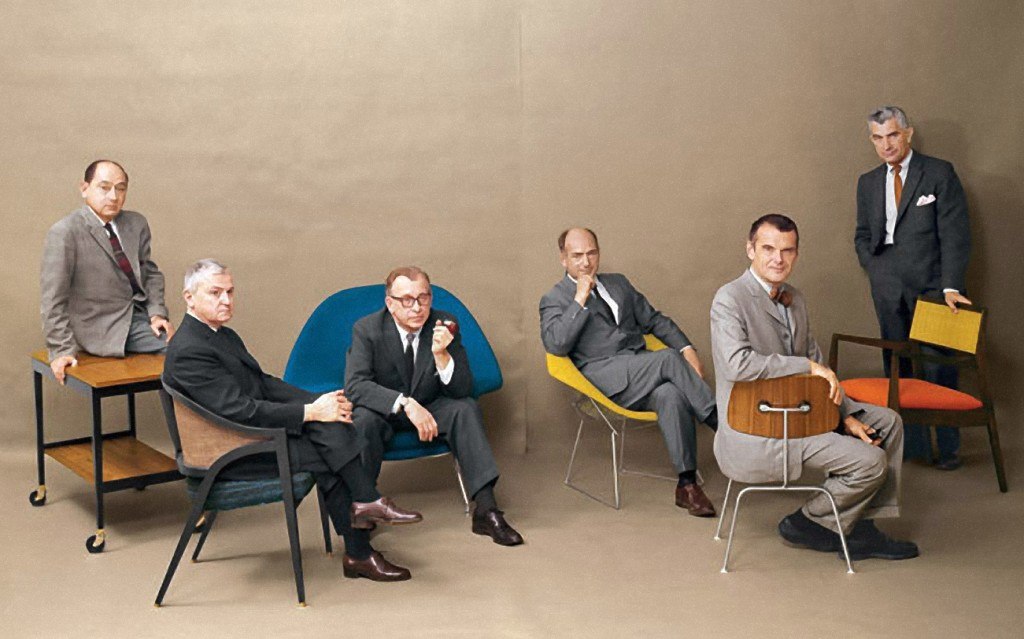
1961 Playboy photo featuring left to right - George Nelson, Edward Wormley, Eero Saarinen, Harry Bertoia, Charles Eames and Jens Risom
Designs for Living
Unfettered by dogma, the creators of contemporary American furniture have a flair for combining functionalism with esthetic enjoyment.
Exuberance, finesse, and high imagination characterize U.S. furniture design today. For the crusading era of modern is over. In the early years of Twentieth Century design, a chair – to its creator, at least – was very much more than something pleasant to look at. An early modern chair was a resoundingly significant expression of the age, a concrete rendition of abstract structural principles, an almost belligerent assemblage of mechanical parts in which every bolt was paraded with all the bravado of Erich von Stroheim’s monocle. Early modern thrived on dogma "Form Follows Function!" "Less is More!" "Structure is Beauty!" that rivaled Milton in Puritan passion; it paid deepest obeisance to the machine and let the softer human sensibilities accommodate themselves as best they could; and it dwelt, along with pre-Bach and post-Bartok, strictly among the intelligentsia.
Today design is more likely to reflect great good spirits than profound philosophies; to relish shapely contours rather than "honest" structures; to pride itself more highly on elegance than earnestness. An early modern chair had an aura of fatalism about it; it had to look the way it did, just as von Stroheim had to spy and torture; it couldn’t help its swift lines and metallic glint any more than Dietrich could help falling in love again. There is nothing inevitable about a chair any longer. Today the machine is the collaborator rather than the determinant of a design. Instead of pressing a cerebral button to solve a mechanical puzzle, the designer brings his unique imagination, his own emotions, to bear at every point in the development of the object. No bulwark of metaphysics is required to justify its every turn. If a bolt is exposed, it is because the designer enjoys the accent, and he is as likely as not to paint the bolt-head black, just for the hell of it. A chair today stands on its own legs in existential – even absurd – delight.
Liberated, fanciful and romantic as today’s design is, it has arrived at this happy condition via a direct route from concepts formulated by the founders of the modern style. In phenomenon perhaps unique in the history of all the arts, a major movement in architecture and design was consciously planned, plotted and programmed from the beginning. "Can you imagine Borromini, Bernini or Guarini proclaiming, ‘We are Baroque!’" muses Gio Ponti, the Italian architect and designer regarded as one of the contemporary greats. "Or Louis XV saying, ‘Let us now invent the Louis Quinze style?’" But that is exactly what the moderns did. They announced to all mankind their objective of revolutionizing the man-made forms of the world, and in order to emphasize the sweeping scope of their program, they titled their mode of expression the International Style.
The early moderns faced a clear and real challenge in the form of the industrial revolution, which had bombarded the world with piecemeal triumphs in science and technology, but had provided no esthetic rationale to guide their use. Objects formerly made by hand were now mass-produced by machines, but they were made to look handcrafted – not out of the maker’s attempt to deceive but simply because he knew no other way to fashion them. Buildings which required only widely-spaced, narrow columns of steel to sustain them nevertheless had thick walls of masonry or brick because the builder could not imagine how else to make a wall. Down that delusory road – in the view of a handful of brilliant German architects and isolated individuals elsewhere, including the great Le Corbusier in France – lay a world of visual meaninglessness, not to say insanity. The Germans – Walter Gropius, Ludwig Mies van der Rohe and Marcel Breuer among them – established in 1919 in Weimar, Germany, a training ground that was to become one of the most powerful molders of esthetic thought in history. Their design school, the Bauhaus, dedicated itself to informing the shapes of the industrialized world with visual significance and esthetic integrity.
The Bauhaus revolutionized art training by synthesizing the teaching of production techniques with the fine arts; it taught that the form an object takes must proceed logically from what it is made of, how it is made, and what it is to be used for. The school banned the slightest ornament, stripped away the smallest nonfunctioning member, and extolled the shiny surfaces and smooth lines that spelled the machine. (In a nice distinction between essential truth and circumstantial fact, they were bothered not a whit that the most flawless "machine look," as exemplified in Mies’ famous Barcelona chair, in fact required meticulous hand attention to achieve.)
When Hitler closed the Bauhaus in 1933 for "decadence", most of the leaders of the school came to the United States; today their basic tenets guide almost all design schools in the Western world. The Bauhaus philosophy is even more comfortably entrenched since the death of its most vociferous rival, Frank Lloyd Wright, who enjoyed calling buildings in the highly geometric International Style "matchbox architecture." Wright’s nature-centered, organic architecture seems to require a master of his own magnitude for satisfactory rendition, and his extremely personal ideas are much less easy to pass on than the clear manifestoes of the Bauhaus.
While later designers have left little inclination to overthrow the principles laid down by the Bauhaus, those tenets are no longer charged with a heady sense of fresh discovery. They are no longer a frontier to be protected or a gospel in need of propagation, but a storehouse of approaches and techniques that a designer can exploit for sensory and emotional possibilities. And the dicta are honored as much in the breach as in the observance. "Wouldn’t it be beautiful," George Nelson, one of today’s major designers, could say three years ago, "to have some kind of sculptured metal leg on a piece of furniture?" – an idea that the Bauhaus would have condemned as frivolous and ungermane to the "soul" of steel. Nelson’s office promptly set about investigating how a suitable sculptured look could be attained by a machine process. That problem solved, Nelson further blasphemed against the Bauhaus commandments by inventing a way to hide the connections where the four sculptured legs, joined together to form a central pedestal.

Eero Saarinen
One of today’s first-rank International Style architects, Eero Saarinen – his original vision of the pedestal chair of 1957 thwarted by an annoying structural unfeasibility – changed the material to meet his visual conception rather than the other (Bauhaus) way around. His hope had been to realize one of the major goals of modern furniture design – a chair in one continuous form and of a single material throughout. He thought he had it in a chair of Fiberglass-reinforced plastic; but when this material turned out to be impractical in the slender pedestal he desired, he sacrificed the single-material objective to the visual grace of the design, made the base of aluminum and gave it a finish of the same color and texture as the plastic seating shell.
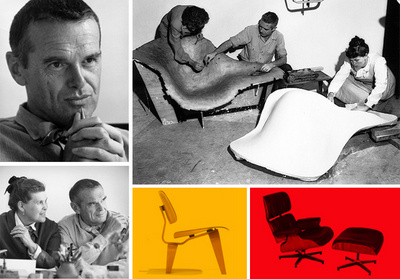
Charles Eames
But it is Charles Eames – the choice of most of his colleagues as the top designer today – who has led the way out of the stark, superrational, industry-focused simplifications of early modern into the subtler amiabilities of contemporary furniture. The famous Eames chair of 1946 was a milestone of modern design. In the best of Bauhaus tradition, every part performed its job with dispatch and lucidity – the contoured, molded plywood seat, the separate, molded plywood back, the no-wasted-effort steel rods to hold back and seat aloft. Each part was simple and economical to produce, and assembly – as devised by Eames – was child’s play.
Even this seemingly matter-of-fact design had an irrepressible bounce about it, its back and seat shapes right in tune with the Joan Miro-Alexander Calder mode of modern art. But it was outdone in lilt by another Eames design five years later, a chair that made a fantasy of a festively complex structure of wire from the ground up. This was the first piece of furniture to exploit the techniques of industry to witty and charming ends.
However playful as forms, both the wire chair and the Eames chair evolved from the practical objective of achieving maximum performance at minimum cost – the cost minimized by ease of mass production and economy of materials. This objective has yielded in later Eames designs to a preoccupation with visual elegance and sumptuous comfort. Eames’ 1958 leisure chair is a beautiful orchestration of sensuous lines and planes, its sculptured bars of aluminum in duet with the outer lines of the seating pad, the pad’s surface in a steady rhythm of horizontal ribs. And then – as if to reward his legion of admirers for never having noticed that his supremely functional original chair, which looked so contour-obliging, could in fact not be sat in with total comfort for more than twenty minutes – Eames’ next design sank the sitter into a voluptuous luxury that few mortals since Nero have known: a broad, deep lounge chair, its cushions covered in soft, wrinkly leather and filled not with the uniformly pneumatic foam rubber so favored in modern design, but with feathers and down – "to give the feeling of settling in," says Eames. "And when you get up the cushions do not instantly pop back into place as though you had never been there." The sense of sheer amplitude is magnified by broadly curved molded frames in luxurious rosewood veneer.
What makes Eames amazing to every other designer is that each new design, so original in conception, has been so fully and naturally resolved that it seems to have been plucked whole from some reservoir of pre-existent ideas, if not from the sky. As a matter of fact, several Eames designs resemble birds, with their blithely molded bodies perched on fragile legs; his latest chair, designed for La Fonda del Sol restaurant in New York, actually sports abstract claws fanning out from its central pedestal. The chair is scheduled to go into mass production shortly.
As befits a genius, Eames is pampered by his manufacturer, the Herman Miller Furniture Company of Zeeland, Michigan. He is under no pressure to produce new designs. Miller is content to wait until inspiration strikes – meanwhile piling up profits from previous models (the original Eames chair is still such a strong seller that Miller maintains a plant solely for its production.) Again as the prerogative of genius, perhaps, Eames avoids the social and professional life of the large and aggressive Los Angeles design community, fiddles around home (a fascinating Santa Monica house made of standard steel building components) or at his studio with his sculptress wife Ray on whatever delectation may come to mind. Other delights beside furniture have sprung from their experiments, including toys, ground-breaking abstract films, and a "sun machine" made of scraps of metal and activated by the sun, which whirs, spins, and buzzes – all to absolutely no purpose. "My dream," Eames has said, "is to have people working on useless projects. These have the germ of new concepts. Our backlog of undeveloped concepts is becoming very low."
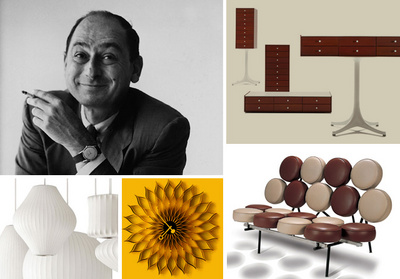
George Nelson
One designer who has been extremely prolific in reducing that backlog is Eames’ friend and fellow designer for Herman Miller – George Nelson. Nelson has either initiated or perfected many innovations which have profoundly affected the organization of the modern house. In his storage wall – an idea he has continued to explore for new variations since the late 1940s – he devised an ingenious system of shelves and supports that could be assembled to accommodate in one out-of-the-way wall all manner of equipment including bar, television, hi-fi and desk, as well as storage space. He was also one of the originators of the now ubiquitous modular system of furniture, in which seating, cabinets, tables and desks are composed of interchangeable parts, adaptable to any new use or whim. An architect as well as a furniture designer, Nelson has always attempted to integrate furniture with architecture to achieve greater space, utility and harmony; and most of his designs for free-standing pieces, such as sofas and armchairs, like his storage walls and modular systems, are simple geometric shapes, usually with raised "platform" seats, to harmonize with the straight lines of the modern house and to preserve its open expanses.
Nelson merrily strayed from his geometric bent with what may appropriately be called a delicious 1956 collection of seating including confections like the marshmallow sofa which plumped people down on an array of individual foam rubber "marshmallows" and a hard-shelled, triangular number called the coconut chair. Impertinent commodities like these, combined with broad curiosity about everything from abstract ideas to semi-abstract clocks (he designed the screen titles for The Misfits and concocted a Camera Three television program called How to Kill People: A Problem in Design), and a critical intelligence that weaves the most irreconcilable contradictions into lucid human organization, has prompted one critic to call Nelson "his own best design." Sociable, articulate and witty to boot, he is in much demand as a speaker and writer.
The kind of modern house for which Nelson planned his near, geometric furniture – a house with open spaces, overlapping volumes, indoor-outdoor flow, and everything possible built in – placed the chair in the limelight. There it stands, in splendid isolation, the most conspicuous piece of furniture in the room. Fittingly, it was one of the top practitioners in that architectural style, Eero Saarinen, who first realized that a different sort of design for a chair was now needed: a chair whose front, back and profile were not discrete views seen in the classical perspective of three separate planes, but a fully rounded object with a form strong enough to stand as an important punctuation mark, complete from any angle. But even that major objective was not the sum of Saarinen’s intent. He also wanted to create a distinctly modern chair, employing industrial materials, that would afford not only the physical fact of comfort, but also the visual atmosphere of comfort associated with traditional upholstered furniture. The now-classic Saarinen womb chair of 1948 was the superb result. One of the first molded plastic chairs, it chose not to expose its hard, smooth material, but to cover itself totally with fabric.
And it chose not to make the least amount of plastic go the farthest way, but to use the material prodigally, in a broadly flaring form imposing in size and inviting in shape. Furthermore, Saarinen minimized the discord between the light, spindly metal rod base and the full, contoured shell by driving the base out of sight, out of mind: metal parts are tucked as near the center as possible without endangering stability, and are thus thrown into shadows created by the generously expansive shell, so that the cradle is all that registered in the senses, like a molded flying carpet.
Saarinen, the cool and silent Finn, son of the later great architect Eliel Saarinen, richly possesses that poetic vision for form which has made the Finns one of the fountainheads of modern design – and design of a delicacy surprising for such a supposedly stolid race. If, from the visually romantic point of view of the Finns, there was anything imperfect about the womb chair, it was that the metal base seemed a bit like an afterthought; it was prudent enough to hide, but it did not participate in the essential mood of the design. Saarinen’s plastic and aluminum pedestal chair, however, resolves every conflict. Although the Bauhaus might have called it dishonest, it is, visually, the very summation of the harmony for which modern design has been striving. In this mellifluously flowing form, only one thin line (not visible from normal viewing angles) where the plastic seat meets the aluminum base reveals that the chair is not all of a single material. Saarinen’s manufacturer, Knoll Associates, Inc., of New York (whose head, Florence Knoll, is herself a formidable design talent), hopes that the technical problems of making the chair in all plastic will eventually be solved.

Harry Bertoia
Sculptors, noting the enviable prominence acquired by the few pieces of furniture isolated in the open spaces of the modern house, have long since seized the opportunity to make them into true pieces de resistance. Isamu Noguchi, the Japanese-American abstract sculptor, turned his evocative vision to furniture in the late 1940s, designing powerful, amorphous, biomorphic shapes (mammary cocktail tables, phallic sofas) that would brook little competition from other objects in a room. A 1952 group of chairs by sculptor Harry Bertoia was planned specifically for modeling in the round, for completeness and interest of form from any angle, three-quarter as well as back, front and profile. Nine years later, still fashionable to the Nth degree, these effervescent beauties in radiant upholstery usually find themselves set at angles in interiors, seldom more than one in a room, and each a star.
Most outré of all furniture designers today are Estelle and Erwine Laverne – a darkly mysterious couple, silent in movement, fiery in temperament, who blaze with a sense of the fabulous. Their flights of fancy include a series of plastic flower-shaped chairs (the tulip, the lotus, the buttercup), and invisible chairs made of clear plastic. These latter, the Lavernes say, are supposed to assist the architectural desire for uncluttered, continuing space, and many find their kaleidoscopic color reflections entrancing. An infernal, science-fiction variation of the clear plastic group is the electric chair, whose edges light up. The Lavernes do not acclaim the architectural virtues of this one.
A warmer, more intimate aspect of modern design – some call it coy – that developed parallel with but independently of the industry-minded Bauhaus mainstream was the crafts-focused Scandinavian school. True Scandinavian designers talk of their work in language similar to that of the Bauhaus gray beards – integrity of materials, exposure of structure, and all that. But what the Bauhaus did out of categorical morality the Scandinavians do out of love. They love the feel and look and warmth and weight of wood, that time-honored material all but ignored by the Bauhaus except in its most machine-done forms, such as molded plywood and steamed bentwood. And the Scandinavians love the idea of handcraftsmanship; they exploit the joys of handwork in gently modulated, sculptured wood surfaces, the turns and joints made poignant by changes in grain markings. While every length of steel and every sheet of plastic looks the same as the next, they are fond of pointing out, each specimen of wood is as individual as a fingerprint.
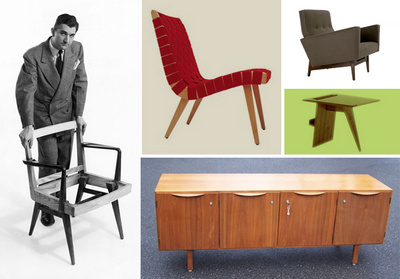
Jens Risom
"People need wood," says Jens Risom the only top Danish designer to make his reputation on American soil – though he is the first to defer to two of his native countrymen, Hans Wegner and Finn Juhl, as the greatest artists in the Danish school. The Metropolitan Museum recently purchased a Wegner chair as its first example of modern design as a work of art. "In these days," Risom elaborates, "when a building is made of glass and steel, people need the live texture, the depth texture that only a piece of wood can give." Risom thinks of a chair as an emotional bridge between architecture and the human occupant, a concept clearly demonstrated by one of his chair designs – its rectilinear wood frame continuing the geometry of the room, its contoured seat and back reflecting the ins and outs of the human form. Risom’s approach to furniture as a craft – as a finished product that is not dreamed up beforehand on paper but that slowly arrives at its character in the actual making – leaves his sense of propriety little choice but to manufacture the furniture himself.
Unlike the imperious, scene-stealing forms of many designers, a Risom chair is a silent partner in an interior, an object for human use that its meaningless until it participates in a pattern of day-to-day living. In this modesty of attitude Risom of course has never been alone. Hans Wegner says, "A chair is not complete until someone sits in it." Paul McCobb – the designer most familiar to young marrieds of the late Forties and early Fifties because of the dining groups and casual chairs which were then sold with phenomenal success under his name in department stores (a new promotional gimmick for such emporiums) – was chiefly responsible for turning the light modern idiom into a way of life for the poplar market.
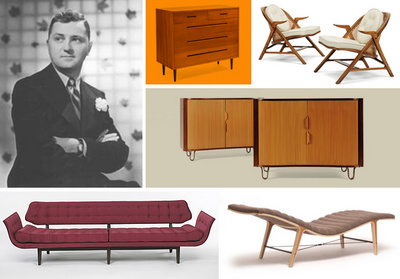
Edward Wormley
T.H. Robsjohn-Gibbings, the British-born designer who has worked in New York for many years, has also dedicated his superbly tailored, generously proportioned furniture to comfortable living, Edward Wormley himself has put it, "News-gatherers, significance-prognosticators, and above all, sales people, need a shot in the arm. Whether the consumer needs it on schedule is more difficult to demonstrate." The pressure of having to conceive a whole new spirit and embody it in an entire collection embracing sofas, lounge chairs, dining furniture, an assortment of occasional tables, cabinetry, and sometimes even beds, would have done in a lesser man long ago. But Wormley’s nightmare is the decorator’s dream; and every January during the furniture show in Chicago, one of the gala events, attended by popping champagne corks and wandering musicians, is the unveiling of Wormley’s new line.
There are those – and some avant-garde designers among them – who believe Wormley’s understated, sympathetic furniture will enjoy favor long after more dramatic, more scintillating modern designs have passed into the stage of old- fashioned curiosities – which seems a certain fate for many of them. Planned as a revolution in form to match a revolution in technology, furniture design of the Bauhaus persuasion can expect a survival span no longer than that of a given state of technology, and today’s designer is realist enough to know that the technology within which he works is certain sooner or later to be replaced by a new set of industrial verities. Against that day, Eames throws his greatest sincerity into "useless projects," Nelson bemuses himself with marshmallows and coconuts, and Saarinen explores the farthest shores of harmony.
Originally appeared in Playboy magazine, July 1961.
